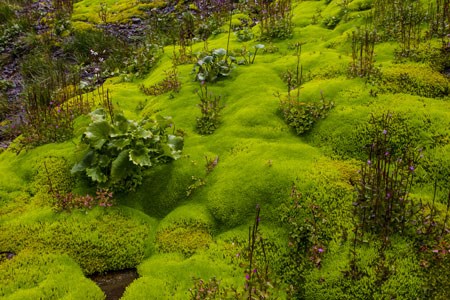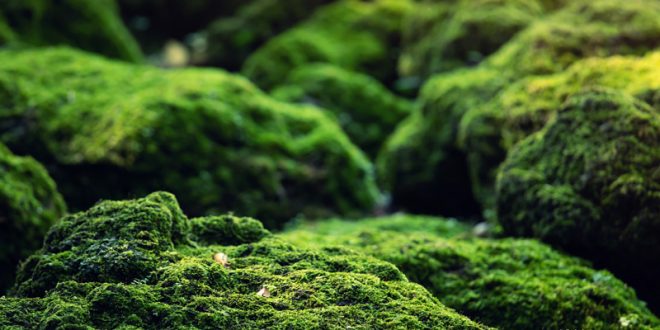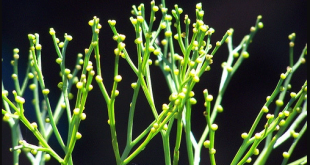Bryophytes are simple non-flowering, non-vascular land plants that reproduce through spores rather than flower or seeds. Bryophytes are often known as a junction or bridge between lower cryptogams and higher cryptogams. Since bryophytes reproduce via spores, their lightweight spores have been dispersed by the wind all over the world, in every atmosphere, environment, and region. Bryophytes have high tolerance even in extreme conditions like in desserts, tundra, rocky surface, mountain surface etc. For this prominence they are often called Cosmopolitan. Bryophyte’s distinctive qualities and attributes have allowed it to thrive in a variety of environments, including dry, wet, snowy, and in any other hostile environments. Bryophytes continue to flourish in moist, somber environments, where they create thick carpets or mats on damp soils, rocks, and tree bark, especially during the rainy season. Bryophyte’s wide expansion throughout the world has made it well acquainted.
Bryophytes in woodland and soil
Bryophytes thrive in thickly forested areas with few or no nutrients in the soil. Liverworts are said to complete land migration but they haven’t adapted to land in a complete sense. Thamnobryum alopecurum (Fox-tail Feather-moss), Thuidium tamariscinum (Tamarisk-moss), Brachythecium rutabulum (Rough-stalked Feather-moss), Kindbergia praelonga (Feather-moss) etc are lowland Bryophytes that grow on woods. Marchantia, Asterlla, Reboulia, Riccia Plagiochasma inhabit in moist environment and grow on damp soil and rock.
Get Free Netflix Now Best safe and secure cloud storage with password protection GPL Themes For Free Get Envato Elements, Prime Video, Hotstar and Netflix For Free Best Money Earning Website 100$ Day Best ever Chat Forum #1 Top ranking article submission website
Bryophytes in tundra region
Mosses can cope even in tundra region like Alaska’s moust tundra. There they extract nutrients from shallow, snow covered soil. They are extremely small and shows a significantly slow growth as well as metabolism. Thus they keep survive in cold. Rhizomnium, Polytrichum (haircap mosses), Giganteum, Dycranum (wind-blown or forked mosses), Sphagnum (peat mosses) etc widely grow on tundra region.

Bryophytes in arid region
Bryophytes, which are components of cryptogrammic crusts, are critical in safeguarding soils in arid places. Lichens, bryophytes, cyanobacteria, green algae, fungus, and the uppermost soil layers generate these crusts by forming intimate associations. Cryptogrammic crusts, which are abundant in arid and semi-arid settings, are the only biological protective layer on the soil surface during droughts. By linking erosion-prone soil particles into more stable soil aggregates, they help to stabilize the soil surface against wind and water erosion. This improves soil infiltration and helps to redistribute runoff across the landscape, which reduces water erosion. Asterella drummondii, Targionia hypohylla, Riccia multifida, Riccia lamellosa, Acaulon and Ephemerum etc bryophytes are inhabitants of of extremely dry or arid or dessert areas.
Bryophytes in aqua
Watery habitat of mosses are pond, river, lakes, brackish water, freshwater etc. However, there are NO marine species of bryophytes. Aquatic moss cushions slow the flow of water and act as filters for floating particles, gathering a lot of Detritus and Periphyton. Bryophytes are also vital as both egg-laying sites and a protected nursery for young larvae, which can seek refuge during floods and eat the plentiful food supplies accessible to them. Because generalist consumers like geese and crayfish prefer angiosperms to aquatic mosses, which make up the majority of the biomass, aquatic bryophytes are desirable refugia for macro invertebrates. Herbivores are deterred by a variety of chemical substances found in moss tissues. As a result, aquatic bryophytes sustain twice as many plant-associated macro invertebrates as riverweed, and macro invertebrate concentrations in aquatic bryophytes are around ten times higher than on the riverbed. Riccia fluitans, Calliergon, Drepanocladus, Marsupella, Thamnobryum are examples of aquatic bryophytes.

Bryophytes in mountain
Mountains, especially tropical mountains have diverse range of Bryophytes. Mosses and liverworts are tiny plants that play an important part in landscape evolution in the Rocky Mountains. They help to avoid erosion by retaining water and stabilizing slopes. Hygrohypnum smithii, Pohlia tundrae, Neckera oligocarpa, Cynodontium are some mountain bryophytes (also alpine).

Bryophytes in swamp forest
Bryophyte species diversity is potentially high in boreal and nemoral forests, particularly in swamp forest types that have a constant high humidity. Sphagnum and other hydrophytes develop a dense surface layer over the water below. From the surface, this covering provides the appearance of earth. Quacking bogs are the name given to these locations. These bogs are later transformed into swamps. Eventually, these marshes are replaced by mesophytic forest growth. Almost all species of bryophytes can grow in swampy land as this genre of land is favorable for them to survive and grow.
Bryophytes are pioneer colonists who settle in disturbed environments. Even though they have a more or less cosmopolitan distribution and can be found in all climates, they can be considered incompletely suited to land circumstances because practically all of them require water for fertilization. The habitats and distribution of bryophytes are vast. They enable angiosperms and other plants to grow in desolate soils and locations and are seen in territories, no other land plant can be seen.
Reference
- Introduction to Bryophytes by Alain Vanderpoorten & Bernard Goffinet
- Botany for degree students: Bryophyta by B.R Vashishta, A.K Sinha & Adarsh Kumar
 Plantlet The Blogging Platform of Department of Botany, University of Dhaka
Plantlet The Blogging Platform of Department of Botany, University of Dhaka




Such a well reaserched and well written content! Got to know so many new things.
Omg everything was so nicely put together, amazing writing looking forward to read more from the author.